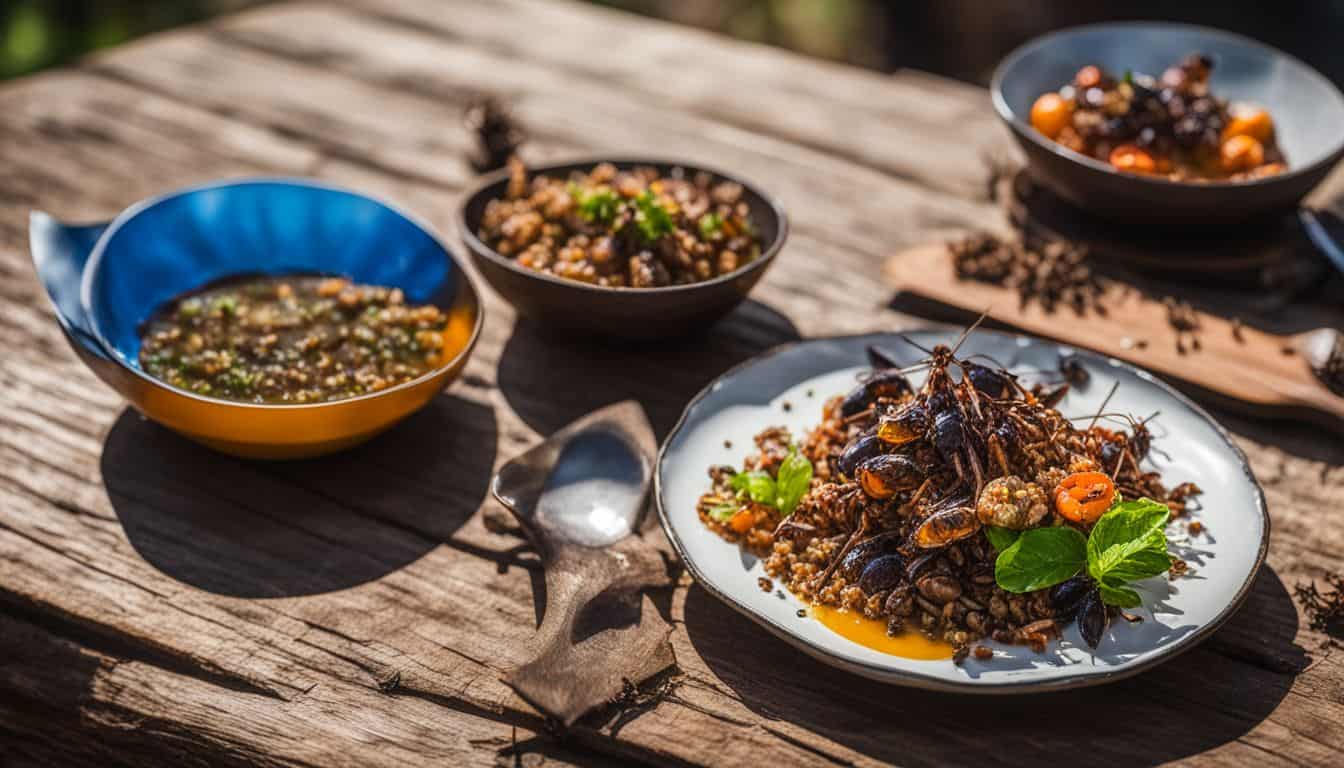Looking for new ways to nourish your body can be a real adventure, especially when traditional food sources are scarce. Did you know that edible insects pack a nutritional punch, and humans have been munching on them throughout history? Our guide dives into the world of six-legged snacks, offering everything you need to make these critters part of your survival diet.
Get ready to crunch into survival nutrition!
Table of Contents
- The Importance of Edible Insects
- Nutritional Value of Edible Insects
- Commonly Consumed Edible Insects
- Top 20 Bugs You Can Eat
- How to Catch and Prepare Edible Insects
- Avoiding Poisonous and Harmful Insects
- Signs an Insect Might Be Unsafe for Consumption
- Sustainability of Edible Insects
- Market Acceptance and Challenges of Insect Foods
- Final Thoughts on Insects You Can Eat
- Can Edible Insects Be a Safe and Reliable Source of Nutrition in Survival Situations?
- FAQs
- Why are edible insects important for survival and nutrition?
- Can eating insects impact the environment positively?
- Do insects contain any health-boosting compounds?
- Are there vegetarian-friendly insects you can eat options available?
- How do bugs you can eat compare to conventional protein sources in terms of nutrition?
- Can we use some kinds of these bugs for more than just food?
- What role do edible insects play in traditional cultures?
- What tools do I need to harvest insects?
- What environmental benefits come from eating insects?
- How do edible insects help global food security?
- How do I store harvested insects?
- Where can I buy edible insects legally?
- What regulations govern insect farming?
- How do different cultures prepare edible insects?
- What equipment do I need to start farming insects?
- How do seasons affect insect harvesting?
Key Takeaways
- Edible insects are a sustainable food source, providing high-quality protein with less environmental impact than traditional livestock.
- Various insects like crickets, ants, termites, and grasshoppers offer essential nutrients such as omega-3 fatty acids, vitamins B12, A, and D, and minerals like iron and zinc.
- Consuming insects can contribute to food security and help reduce reliance on harmful agricultural practices that affect the planet.
- Safety is crucial when foraging for edible bugs – it’s important to correctly identify non-poisonous species and cook them thoroughly to eliminate pathogens or toxins.
- Techniques for catching edible insects include searching under rocks and leaves using nets or light traps, and various cooking methods such as roasting or boiling increase their palatability.
The Importance of Edible Insects
Edible insects offer a key solution in our quest for more sustainable food sources. With the global population rising, traditional meat and fish staples are becoming harder to produce without straining our planet’s resources.
Insect farming is a game-changer, demanding far less land and water than cattle or poultry farming. It produces high-quality protein while emitting fewer greenhouse gases, which is crucial for reducing the impact of climate change.
Embracing insects as food could transform our thinking about nutrition and environmental conservation. Rich in essential amino acids, zinc, vitamin B12, iron, and other micronutrients, they deliver on vital nutritional needs for human health.
Moreover, their cultivation can help decrease reliance on synthetic fertilizers and pesticides known to harm fertile soils. These tiny creatures might just be the superheroes we need to bolster food security and planetary well-being simultaneously.
Nutritional Value of Edible Insects

Edible insects are powerhouses of nutrition, often packed with more protein and healthy fats than traditional meats. Their diverse range of vitamins and minerals makes them a crucial element for survivalist diets and an interesting alternative to everyday cuisine.
High Protein Content
Bugs pack a protein punch that rivals traditional meats like beef and chicken. Many edible insects, from crunchy crickets to savory termites, offer high-quality protein essential for muscle building and repair.
This isn’t just any source of nourishment; it’s a powerhouse of amino acids, the building blocks our bodies need to thrive. Insect proteins can play a significant role in human diets, contributing to health and nutrition far beyond what their size might suggest.
Their compact form hides an impressive nutritional profile, making these tiny critters an excellent choice for anyone seeking alternative protein sources. Given this rich content, consuming insects is not only about surviving but also thriving with a diet that supports strong muscles and good health overall.
Next on the menu: let’s dive into the omega-3 concentration found in many edible insects.
Omega 3s Concentration
High protein isn’t the only standout feature of edible insects; their rich omega-3 fatty acid content is equally remarkable. These essential nutrients, often associated with fish and flaxseeds, are crucial in maintaining heart health and brain function and reducing inflammation.
Edible insects offer a unique opportunity to bolster one’s diet with these vital fatty acids. For those living in regions where fish are scarce or expensive, incorporating insects into meals can be an affordable and environmentally sustainable alternative.
The presence of omega-3s in edible bugs like crickets and grasshoppers makes them survival food and a potential staple for daily nutrition. Consuming these creatures can significantly contribute to human well-being by providing much-needed dietary supplements that support overall health.
Whether you’re looking at beetles or dragonflies, adding variety to your plate with insect foods could provide substantial advantages due to the concentration of beneficial omega-3s they contain.
Vitamins and Minerals
Just as omega-3s are essential for heart health and brain function, so too are the myriad vitamins and minerals found in edible insects. These tiny nutritional powerhouses pack a significant punch when it comes to keeping our bodies healthy.
Edible bugs like grasshoppers, ants, and their crawly kin provide an impressive spectrum of vitamins, including B12, A, and D—nutrients crucial for energy metabolism, immune system strength, and maintaining good vision.
Minerals such as potassium aid in muscle function, while calcium is vital for strong bones. Insects also deliver magnesium, which benefits heart rhythm, along with zinc, which supports the immune system.
Moreover, munching on these critters can boost your iron intake for robust blood health; phosphorus helps build strong teeth; copper assists with nerve functions; and manganese plays a role in bone formation.
Including insects in one’s diet offers a smorgasbord of health benefits without the environmental strain caused by traditional meat farming practices—a win-win for both you and the planet.
Commonly Consumed Edible Insects
Diving into the world of entomophagy, you’ll discover a variety of commonly consumed insects that offer surprising nutritional benefits and serve as sustainable staples in diets around the globe; continue reading to unveil how these tiny critters might just be the superfood of the future.
Grasshoppers and Crickets
Grasshoppers and crickets pack a powerful protein punch, making them an essential part of survival nutrition. Many cultures around the globe count these insects as staples in their diets due to their abundance and high nutritional value.
You can find them hiding under rocks, nestled in decaying logs or camouflaged amidst the leaf litter – all great places for foraging when you’re eating on the run.
Cooking these critters is straightforward and can even be done outdoors with minimal equipment. Skewer a few grasshoppers or crickets and toast them over open flames for a crispy snack, boil them to soften up, or roast them until golden brown for a smoky flavor that some compare to nuts or popcorn.
Whatever method you choose, embracing these insects as food might just pave the way toward environmental sustainability through alternative protein sources.
Ants
Moving from grasshoppers and crickets, ants offer another source of nutrition for those exploring the world of edible insects. Collecting them is a straightforward process—simply tap an anthill with a stick and then submerge it into water to gather the dislodged ants.
Boil these tiny creatures for six minutes to neutralize their acidic content, making them safe and more pleasant to eat.
Ants present not just a survival option but also a culinary experience. Some cultures enjoy incorporating these insects into traditional dishes, as they can add a unique flavor that complements various cooking styles.
Fried or sautéed in some soy sauce, ants can turn into a crunchy garnish on your Tex-Mex ant taco or blend seamlessly into other recipes that may surprise you with their deliciousness.
Termites
Just as ants have secured a spot on the edible insect list, termites are equally important in survival nutrition. Often found in tropical climates, these insects can be an unexpected source of sustenance when foraging for food.
Their bodies are rich in proteins and fats, making them valuable to survival diets.
Termites bring more than just nutritional value to the table; they’re also surprisingly tasty, according to those who consume them regularly. Some cultures even consider them a delicacy and harvest them for their flavor.
They’re typically cooked by roasting or frying, which gives them a satisfying crunch while neutralizing any potential parasites they may carry.
Grubs
Grubs, the juvenile form of beetles, offer a nutritional option for adventurers and survivalists. Rich in protein and easy to find, these wriggling creatures often hide under logs or within decaying leaves.
To catch them, simply turn over damp pieces of wood or dig through leaf litter. Make sure they’re free from pesticides and other harmful chemicals before you plan your meal.
Preparing grubs involves several safe cooking methods, such as skewering them like kebabs or roasting until golden brown. For those willing to try a different taste experience, boiling is another effective way to make grubs edible.
They can provide sustenance in challenging environments where traditional food sources might be scarce. Always ensure proper identification and preparation to enjoy grubs as a sustainable food source without any unwanted risks.
Woodlice
Woodlice, often referred to as “land shrimp,” are a surprisingly edible option that could boost your survival diet. Their flavor is similar to that of shrimp, making them an unexpected delicacy in the wild.
To find these critters, you might want to look under rocks and logs or sift through dead leaves where they tend to hide. Eating woodlice can bring variety and additional nutrients to a survival menu, especially since their small size makes them easy to collect in large numbers.
It’s essential, however, to exercise caution before consuming woodlice or any foraged insects. While they offer nutritional benefits important for survival situations—high in protein and minerals—they may also pose risks if not properly identified or prepared.
Make sure you’re informed about potential allergic reactions or poisonous qualities some bugs may have before adding them to your plate. Woodlice could be not only a viable but also a sustainable food source when conventional foods are scarce or unavailable.
Earthworms
Moving from the lesser-known woodlice, let’s discuss earthworms, a staple of survival nutrition. These wriggly creatures are packed with protein and can often be spotted in their natural habitats, such as under decaying logs or amidst leaf-covered forest floors.
Sourcing them is straightforward if you know where to look – rotting vegetation and moist soil are your best bets for finding these nutritious crawlers.
Once you’ve gathered earthworms, cooking them is crucial to eliminating health risks. They make a practical choice for an emergency diet in the wilderness due to both their availability and nutritional content.
These little critters not only serve as a valuable food source but also help promote sustainable practices by serving as organic fertilizers, which makes incorporating them into survival strategies a doubly beneficial endeavor.
Stinkbugs
Stinkbugs might not be the first thing you think of as a snack, but they are indeed edible and can provide valuable nutrition in survival scenarios. These bugs boast proteins and other nutrients that make them worth considering for your emergency food supply.
Many cultures around the world include stinkbugs in their diet, often roasting or grinding them into seasoning.
Preparing these insects for human consumption involves some specific steps to ensure safety and palatability. You’ll need to catch them carefully, cook them properly to neutralize their characteristic odor, and serve them up in a way that makes the most of their nutritional benefits.
Despite some initial hesitations you may have, embracing stinkbugs as an alternative protein source could be a smart move for those looking toward sustainable eating practices or simply expanding their culinary horizons.
Scorpions
Moving from stinkbugs, let’s delve into another intriguing insect that’s not only edible but also boasts a unique flavor—scorpions. Often spotted in Southwestern states and savored as street food in China, scorpions have secured a spot on the survival nutrition list.
Adventurous eaters and survivalists alike appreciate these arachnids for their nutritional punch. If you’re looking to try one, capture a scorpion by digging a hole near its burrow and scooping it up with a jar.
Once you’ve safely caught your scorpion, cooking is essential to neutralize potential toxins and make it safe for consumption. Methods like skewering them over an open flame or boiling are popular ways to enjoy their crunchy texture and distinct taste.
But proceed with caution: always ensure the scorpion is thoroughly cooked to prevent any allergic reactions or other health risks associated with eating raw arthropods.
Earwigs
Earwigs might make some people squirm at the thought of eating them, but these insects are on the menu for survival situations. Found easily in damp areas or under logs and rocks, earwigs can be a quick source of protein in an emergency.
They may not win any beauty contests with their pincer-like appendages, but don’t let appearances fool you; these creatures can help sustain life when food is scarce.
Catching earwigs involves looking in the right places and using simple techniques to gather them safely. Use gloves or a container to pick them up without getting pinched by their forceps.
Preparing earwigs for consumption requires thorough washing and cooking to ensure they’re safe to eat. Whether you’re sauteing or boiling them, know that adding earwigs into your diet could give you valuable nutrients that keep you going in tough times.
Aphids
Moving on from earwigs, aphids present another option for those considering edible insects. These tiny pests, often found in clusters on the undersides of leaves, are a sustainable food source that can be harvested easily due to their common presence in gardens and farms.
Aphids multiply rapidly, which means there can be an abundant supply without depleting local populations. Their size may require gathering in larger quantities, but they offer a surprisingly sweet taste and are consumed by various cultures around the world.
Aphids have long been studied for their remarkable ability to process plant sap into a sugary substance called honeydew—a favorite of ants—which indicates their potential as a unique addition to survival nutrition.
Including aphids in your diet might provide essential nutrients and contribute to maintaining biodiversity and promoting environmentally friendly food choices aligned with principles of circular economy and sustainability promoted by insect farming innovations.
They could transform agricultural waste into valuable biomass that supports both human consumption and ecological balance.
Maggots
Continuing our exploration of edible insects, let’s examine maggots. Often found in decomposing organic matter, these larvae of flies, like the black soldier fly, have gained attention as a survival food source.
High in protein and fat, they can be an efficient way to obtain crucial nutrients when traditional food supplies are scarce. They’re also used in waste management processes to break down organic materials through their voracious feeding habits.
Maggots must be approached with caution due to potential risks such as allergic reactions or the presence of harmful substances if they’ve consumed toxic materials. It’s important for survivors and adventurers alike not only to know where their maggots come from but also how to safely harvest and prepare them for consumption.
Dragonflies
Dragonflies are a surprising addition to the list of edible insects, with two life-cycle stages available for consumption. Their nymphs dwell in water and present an easier catch, while adult dragonflies require skill to capture mid-flight.
Diverse survival guides mention these creatures because they provide vital nutrients that can be essential when traditional food sources are scarce.
Grabbing dragonfly larvae from their aquatic homes or snatching adults from the air represents a practical method of securing a meal in the wild. Once caught, cooking them quickly ensures safety by eliminating germs; removing wings and legs is optional based on preference.
Moving into how you might transform these winged insects into a palatable dish, let’s explore efficient methods of catching and preparing your next unexpected source of nutrition.
Top 20 Bugs You Can Eat
Here is a list of the top 20 edible insects or bugs that can be eaten, formatted as an ordered list in markdown:
- Crickets
- Mealworms
- Ants
- Grasshoppers
- Cicadas
- Scorpions
- Termites
- June Bugs
- Wax Worms
- Pill Bugs
- Palm Weevil Larvae
- Giant Water Beetles
- Honeybees
- Silkworms
- Mopane Caterpillars
- Aquatic Beetle Larvae
- Black Soldier Fly Larvae
- Tarantulas
- Stink Bugs
- Bamboo Worms
This list is compiled from the information provided in the search results, which mention many of these insects as being commonly eaten around the world, especially in Asia, Africa, and South America. The list covers a variety of insect orders like Orthoptera (crickets, grasshoppers), Coleoptera (mealworms, beetles), Lepidoptera (silkworms, caterpillars), Hymenoptera (ants, bees), and Arachnida (scorpions, tarantulas).[1][2][3]
Citations:
[1] https://www.insectgourmet.com/edible-bugs-species/
[2] https://www.farmersalmanac.com/10-edible-bugs-and-how-to-eat-them
[3] https://www.insectgourmet.com/the-best-insects-to-eat/
[4] https://www.fao.org/edible-insects/84627/en/
[5] https://www.thailandunique.com/edible-insects-bugs
How to Catch and Prepare Edible Insects
Catching and preparing edible insects requires knowledge and skill. Here’s a quick guide to ensure safe and nutritious foraging.
- Identify your target: Research the type of insects that are safe to eat in your area. Use insect identification guides or apps to be sure.
- Dress for success: Wear long sleeves, pants, and gloves to protect yourself from bites, stings, and plants while foraging for insects.
- Timing is key: Hunt for insects early in the morning or late at the evening when they are less active.
- Look in the right places: Search under rocks, logs, and leaves where many edible insects hide during the day.
- Use simple tools: A net can help catch flying insects like locusts or dragonflies, while a light trap attracts nocturnal species.
- Handle carefully: Gently collect insects using jars or containers to avoid crushing them before preparation.
- Clean thoroughly: Wash the bugs in clean water to remove dirt and potential pesticides; some people also recommend boiling them briefly.
- Cook properly: Roasting, boiling, or deep-frying ensures any parasites or bacteria are killed. Cooking also improves flavor and texture.
- Season wisely: Enhance taste with spices, herbs, or marinades. Many find that cooking insects similarly to seafood offers great results.
- Store correctly: If not eating immediately, refrigerate your prepared insects just as you would meat products.
Avoiding Poisonous and Harmful Insects
Safety is paramount in the realm of edible insects; discern between nutritious bugs and those that can cause harm is essential for survival nutrition. Learn the critical distinctions to avoid unwelcome consequences from hazardous insect consumption.
Poisonous Grasshoppers
Poisonous grasshoppers stand out amongst edible insects as ones to steer clear of. Their striking colors or unusual hairiness often signal danger, warning potential predators of their toxicity.
Before considering any grasshopper as a survival food, scrutinize its appearance thoroughly. Brightly colored patterns are nature’s way of saying, “Do not eat!” If you’re unsure about the safety of an insect, it’s best to err on the side of caution and choose another source of nutrition.
Handling these insects requires knowledge and care since they can pose significant health risks if consumed. While many types of grasshoppers provide a good source of protein and nutrients, distinguishing between safe and poisonous varieties is critical for survivalists and adventurers alike.
Learning which characteristics indicate toxicity could be life-saving when in the wild or during emergency situations where alternative food sources become necessary.
Slugs and Snails
Handling slugs and snails requires caution, as these creatures often carry parasites that can be harmful to humans. If they find their way onto your survival menu, cooking them thoroughly is crucial.
This process doesn’t just eliminate any lurking dangers; it also enhances the taste and makes nutrients easier for your body to absorb.
Despite the potential risks, some adventurers might still consider these mollusks as a food source in extreme situations. Cooking slugs and snails can reduce health hazards and provide a meal when options are scarce.
Remember, just like with any wild-caught fare, safety comes first—ensure proper preparation to avoid unwanted illness or adverse effects on your survival endeavor.
Tarantulas
Tarantulas might seem like a formidable choice for an edible insect because of their size and hairy appearance. However, in some cultures, they are considered a delicacy and are eaten for their nutritional value.
These spiders are hunted, typically at night when they are active, and then prepared by removing the hairs, which can cause irritation if ingested.
Cooking tarantulas is quite straightforward once the hairs are removed. They’re often roasted over an open flame until their outer skin becomes crispy. People who have tried them report that tarantulas taste similar to smokey chicken or mild seafood—a tasty survival snack packed with protein! Keep in mind that while these creatures can be safe to eat after proper preparation, some species may still contain toxins; hence, it’s crucial to know which varieties are non-poisonous before you consider adding them to your survival menu.
Bees and Wasps
Bees and wasps’ painful stings frighten many, but beyond the discomfort, they’re not on the menu for survival nutrition. Often buzzing around flowers and nests that are challenging to access, bees and wasps pose risks that outweigh their nutritional benefits.
These flying insects harbor venom that can trigger allergic reactions in some people, making them a less desirable choice when looking for edible insects.
Handling bees requires special care to avoid destroying their vital role in pollination while capturing wasps demands caution due to their aggressive nature. Even expert survivalists like Fred Demara avoid these insects as a food source.
Our focus now shifts to signs an insect might be unsafe for consumption—an essential skill for distinguishing between nourishing bugs and those best left alone.
Caterpillars
Caterpillars are often overlooked as a source of nutrition, but there’s good reason to exercise caution before adding them to your survival menu. While some species are indeed edible and even considered delicacies in certain cultures, identifying the safe varieties can be tricky.
Many caterpillars have defense mechanisms like toxic spines or chemicals that deter predators—including hungry humans.
Eating the wrong kind comes with risks. Some may cause allergic reactions or carry parasites that can lead to health issues. Proper identification is key for those willing to take on the challenge.
It involves understanding which species thrive in your local ecosystem and knowing how to process them safely for consumption. They might not always be readily available or easily spotted due to their camouflage abilities and lifecycle stages, making them a less reliable food source than other insects listed here.
Signs an Insect Might Be Unsafe for Consumption
Edible insects can be nutritious, but knowing which ones to avoid is vital. Some bugs may pose risks to your health if you’re not careful. Here are signs that an insect might be unsafe for consumption:
- Bright Colors: Insects with vivid colors often signal danger and may contain toxins as a defense mechanism against predators.
- Strong Odors: A pungent smell from an insect is usually a warning sign. It could indicate the presence of chemical defenses that are harmful to humans.
- Hairy Bodies: Insects with hairs or bristles can cause irritation or allergic reactions and may carry parasites.
- Unknown Species: If you cannot identify the insect, play it safe and don’t eat it. Many species have look-alikes that could be poisonous.
- Location Matters: Avoid collecting insects from areas with soil acidity or heavy pollution, as they might accumulate toxic substances from their environment.
- Feeding Behavior: Carnivorous insects or those found on dead animals might carry pathogens. When possible, stick to herbivorous species.
- Nighttime Activity: Nocturnal insects, such as certain moths, can indicate toxicity; many feed on poisonous plants at night.
- Warning Sounds: Some bugs produce noises as a deterrent. Be wary of these acoustic signals – they often mean the insect is not safe to eat.
- Aggressive Behavior: Predatory or territorial insects often have stingers or venom for protection, posing obvious risks if consumed.
Sustainability of Edible Insects
Insect farms use less land and water than cattle or poultry, making bugs a sustainable choice for our growing population. They’re champions in converting feed into protein, needing just a fraction of the food cows or chickens require to produce the same amount of meat.
This means fewer greenhouse gases and less strain on our natural resources. Edible insects thrive on organic waste, too, turning what would be trash into high-quality nutrition.
Raising insects like crickets, mealworms, and black soldier fly larvae not only saves valuable resources but also cuts down on pollution. These tiny creatures don’t need much space to grow and can be farmed vertically in urban areas where traditional farming isn’t possible.
As part of sustainable food production systems, they help reduce the environmental footprint of feeding our communities while providing essential nutrients that rival those found in beef or chicken.
Market Acceptance and Challenges of Insect Foods
Sustainability may draw interest, but getting people to bite into the idea of eating insects is entirely different. Consumers often hesitate to add bugs to their plates due to deep-seated cultural preferences and a lack of familiarity with the concept.
For many, there’s a significant ‘yuck’ factor to overcome. Companies are tackling this by presenting insect-based foods in more palatable forms, like protein bars and powders, aiming to shift public perception gently.
Yet even with clever marketing, systemic challenges remain. Regulatory hurdles can be complex as nations grapple with setting standards for insect food safety. Knowing what pests could contaminate crops or how allergens might affect consumers is crucial for market approval.
Equally important is educating potential buyers about the nutritional value of insects and demonstrating that these tiny creatures can pack a big punch when it comes to health benefits such as high protein content and beneficial fatty acids – all while mitigating adverse environmental effects associated with traditional meat production.
Final Thoughts on Insects You Can Eat
Understanding the benefits of edible insects opens up a new frontier in sustainable nutrition. With their impressive protein content and eco-friendly nature, these tiny creatures offer a practical and promising solution for future food security.
Embracing this unconventional yet nutritious food source could be our next step towards a healthier planet and population, one crunchy bite at a time. It’s clear that as we look to feed an ever-growing world, the small but mighty insect may just be the giant leap needed in our global diet revolution.
Can Edible Insects Be a Safe and Reliable Source of Nutrition in Survival Situations?
In survival situations, practicing safe practices for foraging can help ensure that edible insects are a reliable source of nutrition. With the right knowledge, identifying and consuming insects can provide essential protein and nutrients. However, caution and proper identification are necessary to avoid potential risks.
FAQs
Why are edible insects important for survival and nutrition?
Edible insects, like Hermetia illucens and Tenebrio molitor, offer essential nutrients and have higher feed conversion rates than traditional livestock, making them a sustainable choice to support survival nutrition.
Can eating insects impact the environment positively?
Yes! Insects require less land and water than intensive farming of animals fed with soya or fishmeal, mitigating climate change’s effects and reducing eutrophication.
Do insects contain any health-boosting compounds?
Insects are rich in polyphenols, trace elements, and antimicrobial peptides such as defensins, which can help promote health and combat antibiotic resistance.
Are there vegetarian-friendly insects you can eat options available?
Some vegetarians might consider including certain edible caterpillars or other bugs in their diet as meat substitutes that boast high nutritional value without relying on animal products like milk or eggs.
How do bugs you can eat compare to conventional protein sources in terms of nutrition?
Edible insects often provide similar protein levels to those found in beef or fish feeds but come with additional benefits, such as antimicrobial activity against harmful bacteria without needing antimicrobial drugs.
Can we use some kinds of these bugs for more than just food?
Absolutely! In addition to being nutritious food sources, some species, like Isoptera (termites), have been used traditionally in agriculture to assist rice plant growth, while others serve as efficient animal feed alternatives.
What role do edible insects play in traditional cultures?
Indigenous communities harvest seasonal insects as dietary staples throughout the year. Mexican cuisine features chapulines as popular street food and traditional dishes. Australian Aboriginals consider witchetty grubs a sacred food source.
What tools do I need to harvest insects?
Collectors need mesh nets to catch flying insects safely. Storage containers require air holes to keep insects fresh. Gloves protect your hands during collection. Tweezers help sort and clean your harvest.
What environmental benefits come from eating insects?
Insect farming uses 90% less land than cattle ranching. Cricket production creates minimal greenhouse gas emissions. Mealworm farming requires minimal water resources. Insects convert feed to protein more efficiently than livestock.
How do edible insects help global food security?
Insects require minimal space for large-scale production facilities. Farmers can raise insects using food industry byproducts. Insect farms operate year-round in most climates. Local communities can establish sustainable insect farming operations.
How do I store harvested insects?
Keep live insects in ventilated containers at room temperature. Freeze dried insects last six months in airtight containers. Cooked insects stay fresh for three days in the refrigerator. Insect flour maintains freshness for one month in sealed bags.
Where can I buy edible insects legally?
Licensed insect farms sell directly to consumers online. Specialty food stores stock cricket flour and protein bars. Asian markets often carry traditional insect products. Health food stores stock insect-based protein powders.
What regulations govern insect farming?
FDA guidelines control commercial insect production standards. State agriculture departments monitor insect farming facilities. Health departments inspect insect processing operations. Food safety regulations apply to insect-based products.
How do different cultures prepare edible insects?
Thai cuisine features deep-fried water bugs as delicacies. Japanese chefs pickle wasp larvae in soy sauce. Mexican cooks season grasshoppers with lime and chili. Chinese dishes incorporate silkworm pupae.
What equipment do I need to start farming insects?
Basic farming requires temperature-controlled containers. Ventilation systems maintain proper humidity levels. Feeding stations distribute food efficiently. Cleaning tools ensure hygienic conditions.
How do seasons affect insect harvesting?
Spring brings abundant beetle populations. Summer offers peak grasshopper availability. Fall seasons feature optimal ant colony harvesting. Winter requires greenhouse cultivation methods.







Leave a Reply